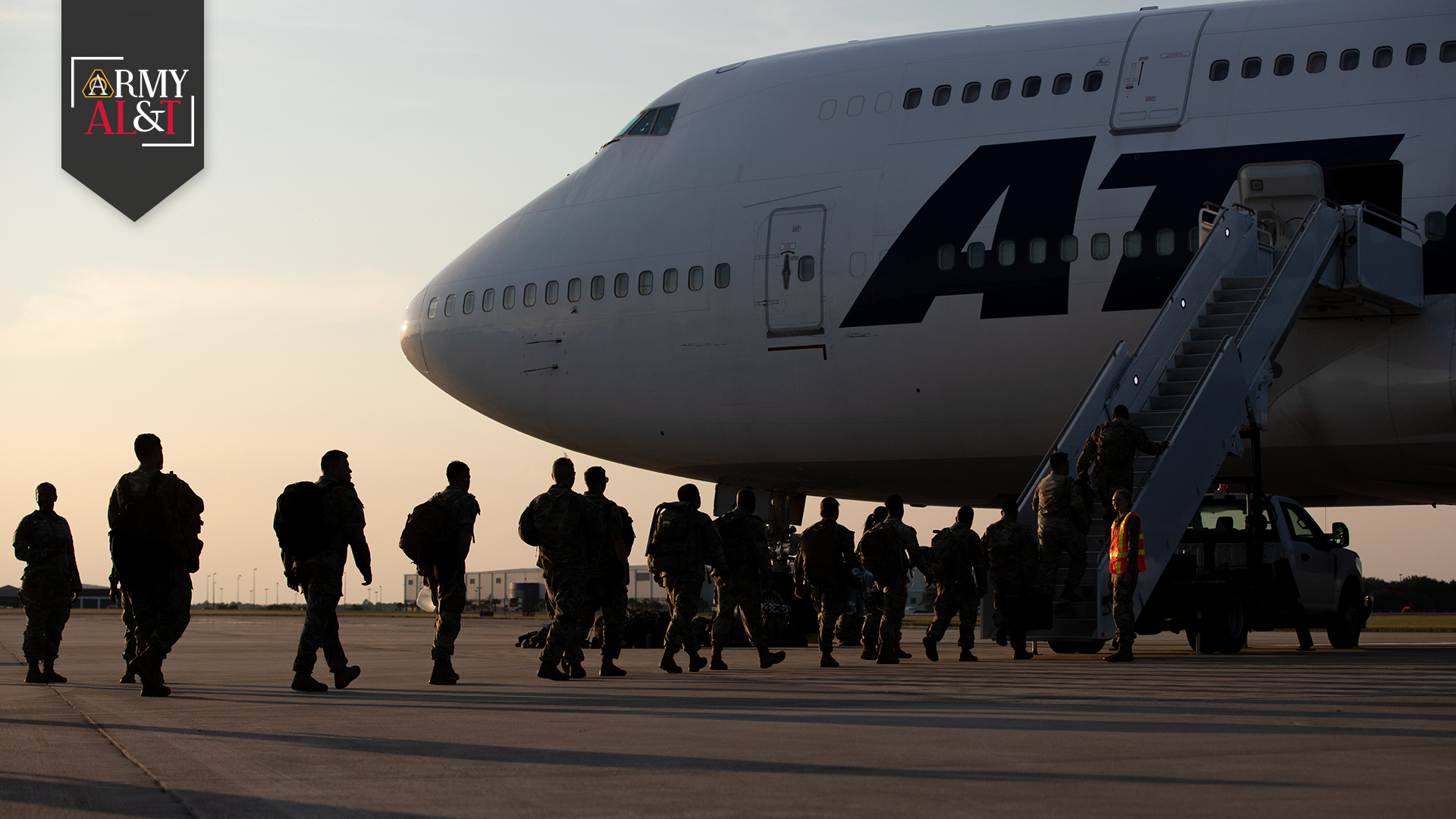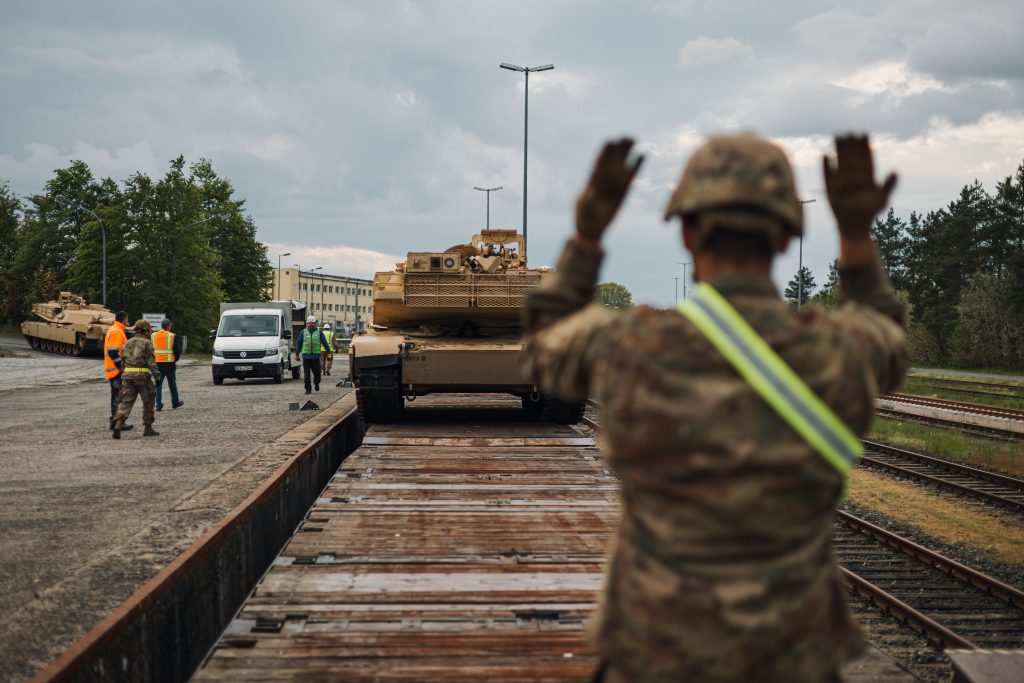
OVERSEAS SUPPORT: U.S. Army Soldiers assigned to 3rd Division Sustainment Brigade, 3rd Infantry Division, board a plane to Europe, July 26, 2023. Members of the AMCAG have been in Europe supporting Army, Joint Force and multinational partners through predictive sustainment since August 2022. (Photo by Sgt. Demetrysean Lewis, 3rd Division Sustainment Brigade)
Ongoing European operations confirm logistics is a critical warfighting function.
by Christopher Hill, Ph.D.
Logistics operations in support of large scale combat operations (LSCO) are complex, and so are the data and analytics that underpin them. Currently, logistics data is managed as a business function. This is because our enterprise business systems facilitate transactions, track movements, and store and manage critical data from the joint strategic support area to the tactical edge. From the tactical edge of ongoing operations today, the reality is that logistics and sustainment operations are about warfighting.
As we build the Army of 2030, and think towards the Army of 2040, we have put new ways of providing decision support at the edge to the test. What we have learned is combatant commanders and the service members they lead have requirements forged by conflict, specific needs that traditional business systems cannot meet. Today’s operational environment has revealed that the speed and complexity of LSCO is unprecedented. A paradigm shift is necessary to keep up with this speed.

LEAD THE WAY: Gen. Charles Hamilton, commander, Army Materiel Command, gives opening remarks for the Contemporary Military Forum on “Sustaining the Army of 2040” at the Association of the U.S. Army Global Force Symposium, March 29, 2023. Hamilton and AMC have been tasked with leading the Army’s strategy for contested logistics. (Photo by Eben Boothby, U.S. Army Materiel Command)
THE TASK
The Army Sustainment Enterprise is leading the strategy for contested logistics. This strategy will require the Army to rethink how it supports the Joint Force—from using new platforms and rewriting doctrine to exploring autonomous resupply and modernizing the Organic Industrial Base. It will inherently involve predictive logistics, which is getting the right equipment to the right place at the right densities, when commanders need it.
Since August 2022, members of the Army Materiel Command Analysis Group (AMCAG) have been in Europe supporting Army, Joint Force and multinational partners through predictive sustainment—and the results speak for themselves. The AMCAG has developed several tools to solve problems in support of U.S. and partner and allied operations. What makes these tools cutting edge is not only the capabilities they provide, but that they incorporate data from multinational partners. For example, in the AMC Predictive Analytics Suite (APAS), one of these tools gives a holistic picture of readiness, where leaders can see what is impacting readiness, what could impact future readiness and ways to mitigate risk. It is comprehensive, showing pieces of equipment that are down (for maintenance or indefinitely), which parts are needed to fix equipment, where the parts are, how long the parts will take to arrive and roughly when the equipment will be repaired and ready to use.

MILITARY TRAINING ASSISTANCE: Logistics data ensures the Army delivers precisely what’s needed to Soldiers, when and where it is needed most. (Photo by Staff Sgt. Oscar Gollaz, 112th Mobile Public Affairs Detachment)
PREDICT THE NEED
Simply put, we are identifying problems and solving them before they occur. We are providing decision support and analytics at the edge. As we approach our second year of support, we have learned important lessons in speed, flexibility, accessibility and simplicity.
Speed
The speed of combat is quicker than ever before, and data analytics must be available for decision support at the speed of combat. Commanders do not have the luxury of waiting eight or more hours for a data-driven answer to a question. They need solutions as soon as possible.
For example, operations can shift quickly, and the forward line of troops can move 50 to 100 kilometers in hours. Commanders may require new forces that are integrated and deployed in a few weeks. Logistics and its supporting analytics must stay ahead of these rapid changes.
Flexibility
In addition to the high speed of combat, the nature of combat has changed. At any given time, the battlefield evolves, and so, too, do the problems commanders face. This is one of the many reasons why it is important to have analytics at the edge. Analysts and their solutions must be positioned to support commanders.
While in Europe, and within a period of three months, requirements for data and analytic operations shifted from counter-offensive to force generation to offensive operations. Conditions changed over time, just as they do in LSCO. Historical processes are not agile enough to allow for decision support at the speed of combat. Tools, platforms and supporting contract vehicles must be flexible to adapt and provide predictive and prescriptive capabilities. Tools must be distributed and federated to push analytic capability to the lowest levels.
Tools must also be flexible to allow multiple contractors to operate in within operational headquarters and enable hybrid contractor and organic support. For example, tasks supporting complex use cases were divided between Army civilians and contractors. It was, and continues to be, critical that the two groups were able to work side by side.
Accessibility
The U.S. Army does not fight alone. In operations, we can expect to work with partners in the Joint Force, as well as foreign military partners and allies.
Current operations include other services, traditional partners like NATO, and nontraditional partners and allies. Each of these need to be able to share data quickly, securely and reap the benefits of advanced analytic operations. This is one of the first times data from different nations is being pulled into a single platform for visualization and analysis to aid decision support.
For example, APAS began as a desktop application. As staff, and then leadership, saw power in the system and its tools, they wanted access. APAS is now a cloud-based platform that leverages information from Army Vantage and non-standard data.
Simplicity
In this digital age, simplicity is critical. Typically, a user does not need to take extensive training to use a phone app. Data solutions should be the same way.
For example, the AMCAG team developed the logistics visualization of current operations to support the Security Assistance Group – Ukraine’s Commander’s Battle Update Briefing in an agile manner, with requirements coming directly from the commander and his staff. This tool continually evolved based on the use of the initial prototypes and user feedback. Adjustments to the tool were made quickly and iteratively. The bottom line is if a data and analytics solution isn’t easy or intuitive to a commander or support staff, they will not use it, and it will fail.

HEADQUARTERS COMMUNICATION: From right, Maj. Shaun Adams, Chief Warrant Officer 3 Cole Brown and Capt. Daniel Reape use the Tactical Mission Data Platform to communicate with headquarters. Soldiers need data-driven answers on the battlefield as soon as possible. (Photo by Spc. William Kuang, 343rd Mobile Public Affairs Detachment)
CONCLUSION
As the Army continues to modernize, predictive sustainment and analytics will continue to play a critical role. We have advanced capabilities now, in the Army of 2024, and as we test them, we are learning, growing and improving. At AMC, it’s our job to deliver sustainment before expected shortfalls in any operational environment. Logistics data ensures we deliver precisely what’s needed, and when and where it’s needed.
As our Army continues aligning itself as a data-centric organization, we must continue to exploit data to provide solutions and maintain readiness. In addition, we must cultivate a data-driven culture and expand upon pockets of excellence. As logistics data continues to prove its worth on the battlefield, a paradigm shift is needed. We must continue to get decision power in the hands of our commanders—our future readiness depends on it.

TRAINING IN SESSION: Soldiers offload U.S. M1A1 Abrams tanks in Grafenwoehr, Germany, May 2023. Logistics and sustainment operations are critical to warfighting. (Photo by Spc. Christian Carrillo, 7th Army Training Command)
For more information, go to https://www.amc.army.mil.
CHRISTOPHER HILL, PH.D., is the chief data and analysis officer at Army Materiel Command. He has served in various analysis leadership positions since joining AMC in 2012. Before working for AMC, Hill retired as a colonel after serving in the U.S. Army for 26 years. He holds a Ph.D. in industrial engineering and management science; and an M.S. in operations research, both from the University of Central Florida and a B.S. in industrial operations management from Auburn University.







